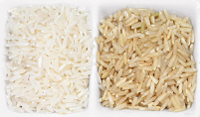The importance of dietary vitamins
 Christaan Eijkman attempted to find the pathogen responsible for feet, breathing problems and heart failure – by injecting chicks with the blood of soldiers who had the disease. Although some animals became ill, he realised that they were all fed on leftovers from the soldiers’ meals. The soldiers were fed on white rice, which had the ‘polishings’ removed to increase its shelf life. He showed that restoring the rice polishings to the diets of the chickens restored their health. Eijkman later discovered that in prisons where brown rice was eaten, beriberi was almost unknown, providing good support for his work.
Christaan Eijkman attempted to find the pathogen responsible for feet, breathing problems and heart failure – by injecting chicks with the blood of soldiers who had the disease. Although some animals became ill, he realised that they were all fed on leftovers from the soldiers’ meals. The soldiers were fed on white rice, which had the ‘polishings’ removed to increase its shelf life. He showed that restoring the rice polishings to the diets of the chickens restored their health. Eijkman later discovered that in prisons where brown rice was eaten, beriberi was almost unknown, providing good support for his work.
Gowland Hopkins showed that illness could be caused by lack of nutrients in the diet in 1912. He investigated the nutritional needs of rats and mice, feeding young rats on casein, lard sucrose, starch and minerals. Half the group also received 2ml of milk daily. Those receiving the milk grew well, and after 2 weeks he switched the groups. The rats which now had milk in their diet began to grow normally, and after staying at the same weight for two weeks, the other group began to fall ill. He suggested that the basic diet must lack some fundamental nutrient (later termed vitamin A), and that this problem was similar to diseases caused by poor diet in humans.
Last edited: 27 August 2014 06:01
